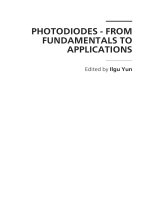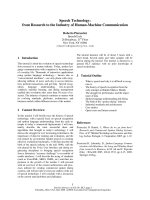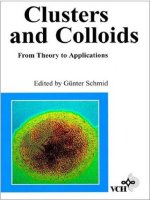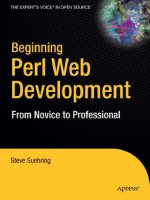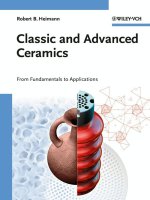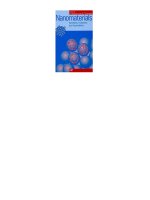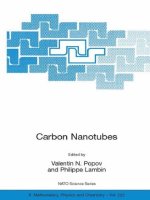- Trang chủ >>
- Khoa Học Tự Nhiên >>
- Vật lý
nanomaterials. from research to applications, 2006, p.475
Bạn đang xem bản rút gọn của tài liệu. Xem và tải ngay bản đầy đủ của tài liệu tại đây (15.11 MB, 475 trang )
Nanomaterials:
From Research to Applications
This page intentionally left blank
Nanomaterials:
From Research to Applications
H. Hosono, Y. Mishima, H. Takezoe, and K.J.D. MacKenzie
Tokyo Institute of Technology, JAPAN
Amsterdam • Boston • Heidelberg • London • New York • Oxford
Paris • San Diego • San Francisco • Singapore • Sydney • Tokyo
Elsevier Ltd, The Boulevard, Langford Lane, Kidlington, Oxford OX5 1GB UK
Elsevier BV, Radarweg 29, PO Box 211, 1000 AE, Amsterdam, The Netherlands
Elsevier Inc., 525 B Street, Suite 1900, San Diego, CA 92101-4495, USA
Elsevier Ltd, 84 Theobald’s Road, London, WC1Z 8RR, UK
© 2006 Elsevier Ltd. All rights reserved.
This work is protected under copyright by Elsevier Ltd, and the following terms and conditions apply to its use:
Photocopying
Single photocopies of single chapters may be made for personal use as allowed by national copyright laws. Permission of the
Publisher and payment of a fee is required for all other photocopying, including multiple or systematic copying, copying for
advertising or promotional purposes, resale, and all forms of document delivery. Special rates are available for educational
institutions that wish to make photocopies for non-profit educational classroom use.
Permissions may be sought directly from Elsevier’s Rights Department in Oxford, UK: phone (+44) (0) 1865 843830; fax
(+44) (0) 1865 853333; e-mail: Requests may also be completed on-line via the Elsevier homepage
( />In the USA, users may clear permissions and make payments through the Copyright Clearance Center, Inc., 222 Rosewood
Drive, Danvers, MA 01923, USA; phone: (+1) (978) 7508400, fax: (+1) (978) 7504744, and in the UK through the Copyright
Licensing Agency Rapid Clearance Service (CLARCS), 90 Tottenham Court Road, London W1P 0LP, UK; phone: (+44)
20 7631 5555; fax: (+44) 20 7631 5500. Other countries may have a local reprographic rights agency for payments.
Derivative Works
Tables of contents may be reproduced for internal circulation, but permission of the Publisher is required for external resale
or distribution of such material. Permission of the Publisher is required for all other derivative works, including compilations
and translations.
Electronic Storage or Usage
Permission of the Publisher is required to store or use electronically any material contained in this work, including any chapter
or part of a chapter.
Except as outlined above, no part of this work may be reproduced, stored in a retrieval system or transmitted in any form or by
any means, electronic, mechanical, photocopying, recording or otherwise, without prior written permission of the Publisher.
Address permissions requests to: Elsevier’s Rights Department, at the fax and e-mail addresses noted above.
Notice
No responsibility is assumed by the Publisher for any injury and/or damage to persons or property as a matter of products
liability, negligence or otherwise, or from any use or operation of any methods, products, instructions or ideas contained in
the material herein. Because of rapid advances in the medical sciences, in particular, independent verification of diagnoses
and drug dosages should be made.
Library of Congress Control Number: 2006927673
First edition 2006
ISBN-13: 978-0-08-044964-7
ISBN-10: 0-08-044964-6
The paper used in this publication meets the requirements of ANSI/NISO Z39.48-1992 (Permanence of Paper).
Printed in Great Britain
060708091010987654321
v
Contents
Preface x
Materials Research at the Tokyo Institute of Technology
Seizo Miyata xi
List of Contributors xiv
Part I Revolutional Oxides
1 Function Cultivation in Transparent Oxides Utilizing
Natural and Artificial Nanostructures 3
Hideo Hosono and Masahiro Hirano
1.1 General Introduction 4
1.2 Transparent Oxide Semiconductors 7
1.3 Transparent Nanoporous Crystal 12CaO·7Al
2
O
3
24
1.4 Encoding of Periodic Nanostructures with Interfering
Femtosecond Pulses 40
References 57
2 The Role of Lattice Defects in Oxides 62
Mitsuru Itoh
2.1 Introduction 62
2.2 Magnetic Materials (Spin Crossover in Oxides) 63
2.3 Ferroelectric Materials 72
2.4 Lithium Ion Conductivity in Oxides 79
vi Contents
2.5 Concluding Remarks 91
2.6 Clue to the Design of New Functional Oxide Materials 93
References 95
3 Size Effect of Ferroelectric and High Permittivity
Thin Films 99
Hiroshi Funakubo
3.1 Introduction 99
3.2 Size Effect of Ferroelectricity in PZT Thin Films 101
3.3 Size-Effect-Free Characteristics of Bismuth Layer
Structured Dielectrics 107
3.4 Summary and Future Aspects 131
References 131
Part II State-of-the-Art Polymers
4 Photonic Devices using Liquid Crystal Nanostructures 137
Hideo Takezoe
4.1 Photonic Effect 137
4.2 Lasing from CLCs 148
4.3 Optical Diode 160
4.4 Concluding Remarks and Future Problems for Practical
Applications 167
References 168
5 Nanocylinder Array Structures in Block Copolymer
Thin Films 171
Kaori Kamata and Tomokazu Iyoda
5.1 General Introduction 171
5.2 Synthesis of Block Copolymers 172
5.3 Self-organization and Phase Behavior of Block Copolymer
Microdomains 173
5.4 Phase-segregated Nanostructures in Block Copolymer
Thin Films 191
5.5 Phase-segregated Nanostructures in Thin Films Effective for
Practical Use Cylindrical Phases in Block Copolymer
Thin Films 194
Contents vii
5.6 Nanocylindrical-structured Block Copolymer Templates 210
5.7 Summary and Future Directions 215
References 216
6 Nano-Size Charge Inhomogeneity in Organic Metals 224
Takehiko Mori
6.1 Introduction 224
6.2 Universal Phase Diagram of the θ-Phase 226
6.3 Charge Order 231
6.4 Theoretical Background and Estimation of V 240
6.5 Discussion 255
6.6 Summary 257
References 258
Part III Nanostructure Design for New Functions
7 Size Control of Nanostructures by
Quantum Confinement 265
Hiroyuki Hirayama
7.1 Introductory Remarks 265
7.2 Quantum Well States in Surface Nanostructures 267
7.3 Size Control of Nanostructures via Quantum Confinement 278
7.4 Practical and Future Applications 291
7.5 Summary 295
References 295
8 Grain Boundary Dynamics in Ceramics
Superplasticity 297
Fumihiro Wakai and Arturo Domínguez-Rodríguez
8.1 Introduction 297
8.2 Motion and Topological Evolution of Grains 298
8.3 Physical Characteristics of Ceramics Superplasticity 304
8.4 Grain Refinement and Suppression of Grain Growth 305
8.5 Diffusion Enhancement 306
8.6 Superplastic Forming 309
8.7 Future Prospects 310
References 310
viii Contents
9 Nanostructure Control for High-strength and
High-ductility Aluminum Alloys 315
Tatsuo Sato
9.1 Introduction 315
9.2 History of High-strength and High-ductility Aluminum
Alloys 316
9.3 Discovery of GP Zones 319
9.4 Clusters in the Early Stage of Phase Decomposition 320
9.5 Ductility and PFZ Control by Nanoclusters 342
9.6 Summary 344
References 344
Part IV Nanostructure Architecture for
Engineering Applications
10 Nanoporous Materials from Mineral and
Organic Templates 349
Kiyoshi Okada and Kenneth J.D. MacKenzie
10.1 Historical Background and Development 349
10.2 Review of the Porous Properties of Nanoporous Materials
Produced Using Mineral Templates 357
10.3 Practical/Future Applications Related to Various
Properties 373
10.4 Summary 378
References 379
11 Enhancement of Thermoelectric Figure of Merit
through Nanostructural Control on Intermetallic
Semiconductors toward High-temperature
Applications 383
Yoshinao Mishima, Yoshisato Kimura and Sung Wng Kim
11.1 Background and Principles 384
11.2 Bulk Intermetallic Semiconductors for Future
High-temperature Applications 390
11.3 A Breakthrough in ZT: Nanostructured Materials 405
References 414
Contents ix
12 Smart Coatings – Multilayered and Multifunctional
in-situ Ultrahigh-temperature Coatings 419
Hideki Hosoda
12.1 Introduction 420
12.2 Oxidation Resistance of Ir 421
12.3 Design of Multifunctional and Multilayered Coating Based
on IrAl 423
12.4 Physical Properties of IrAl Alloys 425
12.5 Oxidation Behavior of Ir-rich IrAl 433
12.6 Oxidation Behavior of Al-rich IrAl Alloys 437
12.7 Oxidation Behavior of Co-added IrAl 440
12.8 Summary 444
References 445
Index 447
x
Preface
A proposal submitted by the professors working in the area of Materials Science at the
Tokyo Institute of Technology was selected as one of the twenty-first Century COE
(Center of Excellence) programs entitled “Nanomaterial Frontier Cultivation for Indus-
trial Collaboration”. The objective of the project is to foster innovation in the field of
nanomaterials, building on the strong tradition of Materials Science at the Tokyo Insti-
tute of Technology, typified by the success of the ferrite and polyacetylene materials
developed there.
This book, which summarizes the achievements of this COE program, is divided into
four parts: (1) Revolutional Oxides, (2) State-of-the-Art Polymers, (3) Nanostructure
Design for New Functions, and (4) Nanostructure Architecture for Engineering Appli-
cations. Each part consists of three or four chapters related to inorganic, organic, and
metallic nanomaterials.
This book is published with the support of the COE program. All the contributors in
this program are grateful for the continuous support by the JSPS (Japan Society for
the Promotion of Science). Acknowledgment is also given to the Tokyo Institute of
Technology for its encouragement of this activity and its financial support. Finally, sincere
thanks are due to Elsevier Science Ltd. for assistance with editing the manuscripts and
for publishing this book.
Hideo Hosono
Kenneth MacKenzie
Yoshinao Mishima
Hideo Takezoe
xi
Materials Research at the
Tokyo Institute of Technology
Seizo Miyata
Professor Shirakawa is presented with the Nobel Prize by King Gustov
(Courtesy of Professor Kenneth J. Wynne)
The Tokyo Institute of Technology was originally founded as the Tokyo Vocational School
in May 1881. The School was renamed as the Tokyo Technical School in 1890 and later
became the Tokyo Higher Technical School in 1901. In 1929, the Tokyo Technical
School was promoted to the status of a degree-conferring university and was renamed
as the Tokyo Institute of Technology. Its new mission was to impart higher education to
professional engineers and develop their capabilities for research and development, in
order to contribute to the modernization of Japanese industries.
xii Materials Research at the Tokyo Institute of Technology
Materials research has been actively carried out throughout the entire history of the
University. Currently, the Tokyo Institute of Technology is one of the best educational
and research centers for materials science, not only in Japan but also by world standards,
as shown in the following chapters.
In its history spanning more than a century, two Professors of the Tokyo Institute of
Technology, Professor Yogoro Kato and Professor Hideki Shirakawa, stand out from the
many excellent Professors of Materials Science.
Professor Yogoro Kato (1872–1967) was invited to join the Tokyo Higher Technical
School as a Professor in 1907 and began the study of metal oxides with his former
student Professor Takeshi Takei in 1929. Soon they discovered the existence of strong
magnetization in ferrite even though it was an insulator. Thus began the application of
ferrites to modern electronics and the era of ferrite technology was launched in 1932.
Three years later, the TDK Corporation was founded to industrialize these inventions,
and it is currently one of the world’s leading electronics components manufacturers, with
31 000 employees.
In 1939, Professor Kato donated all his patent royalties to the Tokyo Institute of
Technology to establish the Chemical Research Laboratory where Professor Shirakawa
was to begin his career later as an Assistant Professor. Professor Hideki Shirakawa
(1936–present), who was the Nobel Laureate for Chemistry in 2000, graduated from
the Tokyo Institute of Technology with a degree in chemical engineering in 1961 and
enrolled in the graduate program there, receiving his doctorate in engineering in 1966.
Immediately on receiving his PhD, he was hired as an Assistant Professor at the Chem-
ical Resources Laboratory of the Tokyo Institute of Technology and began working on
the polymerization of polyacetylene, the work for which he received the Nobel Prize.
On this occasion, he wrote:
In the fall of 1967, only a short time after I started, I discovered polyacetylene film through
an unforeseeable experimental failure. With the conventional method of polymerization,
chemists had obtained the compound in the form of a black powder; however, one day,
when a visiting scientist tried to make polyacetylene in the usual way, he only produced
some ragged pieces of a film. In order to clarify the reason for the failure, I inspected
the various polymerization conditions again and again. I finally found that the concentra-
tion of the catalyst was the decisive factor for making the film. In any chemical reaction,
a very small quantity of the catalyst, of the order of m·mol, would be sufficient, but
the result I got was for a quantity of mol, a thousand times higher than I had intended.
It was an extraordinary unit for a catalyst. I might have missed the “m” for “m·mol” in
my experimental instructions, or the visitor might have misread it. For whatever reason,
he had added the catalyst in molar quantities to the reaction vessel. The catalyst concen-
tration a thousand-fold higher than I had planned had apparently accelerated the rate of
the polymerization reaction about a thousand times. Roughly speaking, as soon as acety-
lene gas was put into the catalyst, the reaction occurred so quickly that the gas was just
polymerized on the surface of the catalyst as a thin film.
Materials Research at the Tokyo Institute of Technology xiii
The film, which was shiny as an aluminum foil, was more intriguing than the rather
uninteresting black powder that was normally synthesized, and gave very simple IR
absorption spectra. Incidentally during 1975, Professor Alan MacDiarmid of the Univer-
sity Pennsylvania (UPenn) was visiting Japan to lecture on the electrically conducting
inorganic polymer sulphur nitride, (SN)x. He met Professor Shirakawa on learning that a
gleaming polymer film had been invented. As soon as he went back to UPenn, he called
Dr. Kenneth Wynne, the Program Manager of the Office of Naval Research (presently a
Professor at the Virginia Commonwealth University) who promptly decided to support
the new project because he felt that it fitted well with his funding policies, which were
“to try to find innovative projects to try to place funding in focus areas which would
have “impact” something like picking good stocks.”
In his capacity as a Visiting Scholar, Dr. Shirakawa met Professor Heeger, who was
working on one-dimensional electrical conducting organic materials in which the con-
ductivity upon doping. The separate threads soon came together at UPenn. when a novel
type of electrical conducting polymer was discovered. On November 23, 1976, when
Shirakawa and a post-doctoral research Fellow of Professor Heeger were measuring the
electrical conductivity of polyacetylene, there was a sudden surge in the conductivity
over seven orders of magnitude when it was doped with bromine.
Currently, electrically conducting polymers show promise for display technology appli-
cations such as polymer light emitting diodes, transparent electrodes for switching LC
displays, and so on.
Other Professors of the Tokyo Institute of Technology who have made significant con-
tributions to society as materials scientists include Professor Issaku Koga (1891–1982),
who developed high precision clocks using quartz crystals and Professor Shu Kambara
(1906–2000), who in 1941 discovered a novel method for the production of poly-
acrylonitrile fiber.
xiv
List of Contributors
Seizo Miyata
(21st COE Professor)
Senior Program manager,
Fuel cell and Hydrogen,
Technology Development Dept.
New Energy and Industrial Tchnology
Development Organization
20F Muza Kawasaki Building, 1310,
Omiya-cho, Saiwai-ku, Kawasaki
Kanagawa 212-8554, Japan
E-mail:
Tel: & Fax: +81-44-520-5262
Hideo Hosono
Professor, Frontier Collaborative
Research Center,
Tokyo Institute of Technology,
Nagatsuta 4259, Mail Box R3-1,
Midori-ku, Yokohama 226-8503
E-mail:
Tel: +81-45-924-5359
Fax: +81-45-924-5339
Masahiro Hirano
21st COE professor,
Frontier Collaborative Research Center,
Tokyo Institute of Technology,
Nagatsuta 4259, Mail Box S2-13,
Midori-ku, Yokohama 226-8503
E-mail:
Tel: & Fax: +81-45-924-5127
Mitsuru Itoh
Professor, Materials and Structures
Laboratory
Tokyo Institute of Technology,
Nagatsuta 4259, Mail Box J2-19,
Midori-ku, Yokohama 226-8503
E-mail:
Tel: & Fax: +81-45-924-5354
Hiroshi Funakubo
Associate Professor, Department
of Innovative and Engineered
Materials,
Tokyo Institute of Technology,
Nagatsuta 4259, Mail Box J2-43,
Midori-ku,
Yokohama 226-8503
E-mail:
Tel: & Fax: +81-45-924-5446
Hideo Takezoe
Professor, Department of Organic and
Polymeric Materials
Tokyo Institute of Technology,
O-okayama, 2-12-1, Mail Box S8-42,
Meguro-ku,
Tokyo 152-8552
E-mail:
Tel: +81-3-5734-2436
Fax: +81-3-5734-2876
List of Contributors xv
Tomokazu Iyoda
Professor, Chemical Resources
Laboratory
Tokyo Institute of Technology,
Nagatsuta 4259, Mail Box R1-25,
Midori-ku, Yokohama 226-8503
E-mail:
Tel: +81-45-924-5266
Fax: +81-45-924-5247
Takehiko Mori
Professor, Department of Chemistry
and Materials Science
S8-31 Tokyo Institute of Technology,
O-okayama, 2-12-1, Mail Box S8-31,
Meguro-ku, Tokyo 152-8552
E-mail:
Tel: +81-3-5734-2427
Fax: +81-3-5734-2876
Hiroyuki Hirayama
Professor, Department of Materials
Science and Engineering
Interdisciplinary Graduate School of
Science and Engineering
Tokyo Institute of Technology,
Nagatsuta 4259, Mail Box J1-13,
Midori-ku, Yokohama 226-8503
E-mail:
Tel: +81-45-924-5637
Fax: +81-45-924-5685
Fumihiro Wakai
Professor, Materials and Structures
Laboratory, Tokyo Institute of
Technology,
Nagatsuta 4259, Mail Box R3-23,
Midori-ku, Yokohama 226-8503
E-mail:
Tel: +81-45-924-5361
Fax: +81-45-924-5390
Arturo Dominguez-Rodrigues
Professor, Department of Solid State
Physics, University of Sevilla
Apto. 1065, 41080 Sevilla, Spain
E-mail:
Tel: +34-954-557-849
Fax: +34-954-612-097
Tatsuo Sato
Professor, Department of Metallurgy and
Ceramics Science, Tokyo Institute of
Technology,
O-okayama, 2-12-1, Mail Box S8-13,
Meguro-ku, Tokyo 152-8552
E-mail:
Tel: & Fax: +81-3-5734-3139
Kiyoshi Okada
Professor, Department of Metallurgy and
Ceramics Science, Tokyo Institute of
Technology,
O-okayama, 2-12-1, Mail Box S7-7,
Meguro-ku, Tokyo 152-8552
E-mail:
Tel: +81-3-5734-2524
Fax: +81-3-5734-3355
Kenneth J.D. MacKenzie
Professor, MacDiarmid Institute for
Advanced Materials and Nanotechnology,
Victoria University of Wellington,
P.O. Box 600, Wellington, New Zealand
& Visiting COE Professor, Department of
Metallurgy and Ceramics Science,
Tokyo Institute of Technology,
O-okayama, Meguro, Tokyo 152-8552,
Japan
E-mail:
Tel: +64-4-463-5885
Fax: +64-4-463-5237
xvi List of Contributors
Yoshinao Mishima
Professor, Department of Materials
Science and Engineering
Interdisciplinary Graduate School of
Science and Engineering
Tokyo Institute of Technology,
Nagatsuta 4259, Mail Box G3-23,
Midori-ku, Yokohama 226-8502
E-mail:
Tel: & Fax: +81-45-924-5612,
Yoshisato Kimura
Associate, Department of Materials
Science and Engineering
Interdisciplinary Graduate School of
Science and Engineering
Tokyo Institute of Technology,
Nagatsuta 4259, Mail Box G3-23,
Midori-ku, Yokohama 226-8502
E-mail:
Tel: & Fax: +81-45-924-5495
Sung Wng Kim
Research Fellow, Frontier Collaborative
Research Center,
Tokyo Institute of Technology,
Nagatsuta, 4259, Mail Box S2-13,
Midori-ku, Yokohama 226-8503,
Japan
E-mail:
Tel: & Fax: +81-45-924-5127
Hideki Hosoda
Associate Professor,
Advanced Materials Division,
Precision and Intelligence
Laboratory, Tokyo Institute of
Technology,
Nagatsuta 4259, Mail Box R2-27,
Midori-ku, Yokohama 226-8503
E-mail:
Tel: & Fax: +81-45-924-5057
PART I
Revolutional Oxides
This page intentionally left blank
CHAPTER 1
Function Cultivation in Transparent Oxides
Utilizing Natural and Artificial Nanostructures
Hideo Hosono and Masahiro Hirano
Abstract
In this chapter, we review the recent progress in optoelectronic applications of trans-
parent wide band gap oxides. We concentrate especially on creating new functions in
transparent oxides by forming or utilizing nanostructures embedded in the materials.
First, our material design concept is introduced in relation to the electronic structures
of the oxides. Then optoelectronic properties, electronic structures, and device appli-
cations are reviewed for (1) layered oxychalcogenides LnCuOCh (Ln = lanthanide,
Ch = chalcogen), and (2) nanoporous crystal 12CaO.7Al
2
O
3
(C12A7). Finally, fabrica-
tion of periodic nanostructures in transparent materials by interfering femtosecond (fs)
laser pulses is reviewed. Sharp blue-to-UV light emission was observed in LnCuOCh
originating from room-temperature stable exciton and the stability of exciton is dis-
cussed in relation to their two-dimensional electronic structures. C12A7 has free oxygen
ions clathrated in its subnanometer-sized cages, and new functions may be added to
C12A7 by replacing the free oxygen ions with active anions. Quantum calculations
indicate that cages trapping electrons in C12A7 can be regarded as quantum dots.
Micro/nano-processing techniques using fs pulses is an emerging approach to adding new
functions to transparent materials. A distributed feedback laser structure was fabricated
solely using the laser pulses and its oscillation at room temperature was demonstrated.
Keywords: transparent oxide semiconductor, transparent conductive oxide, oxide
electronics, electride, defect reengineering, nano-fabrication, laser-processing,
femtosecond laser, nano-porous materials.
Nanomaterials: From Research to Applications
H. Hosono, Y. Mishima, H. Takezoe and K.J.D. MacKenzie
© 2006 Elsevier Ltd. All rights reserved
3
4 Nanomaterials: From Research to Applications
1.1 General Introduction
1.1.1 Research background
The Clerk number shows the order in terms of natural abundance of the elements in
the earth’s crust. The top ten on the list are oxygen, silicon, aluminum, iron, calcium,
sodium, potassium, magnesium, hydrogen, and titanium. Human beings have created
civilization utilizing materials consisting of these elements, i.e., oxides of the light or
main group metals (Al
2
O
3
, SiO
2
, CaO, and MgO) in the Stone Age, and Fe in the Iron
Age, and the current Information Age is supported by Si-based semiconductor integrated
circuits and SiO
2
-glass fibers. There is no doubt that the coming age will be created
using these abundant elements intelligently.
Oxide ceramics are probably among the oldest man made materials and because of their
excellent properties including abundance and easy availability of ingredients, mechani-
cal strength, and excellent durability against severe chemical and thermal environments,
they have been widely used mostly for structural components since ancient times.
In addition, superior optical transparency of oxides makes it possible to realize vari-
ous optically passive components in recent years: a representative example is ‘optical
fiber’ used for optical communication systems, which is responsible for ushering in the
current Information Age. However, it has been believed that active functions based on
‘the control of the density and polarity of mobile carriers,’ a control realized in semicon-
ductor materials, are not possible in oxides. For example, alumina and glasses, which
are representative oxides, are optically transparent but electrically insulating, and even
the modification of electronic conductivity in these materials is rather difficult. However,
In-doped SnO
2
(ITO) was discovered in 1953, and it exhibits both optical transparency
and electrical conductivity. ITO is used as transparent electrodes, which are unavoidable
for flat-panel displays and solar cells, and a category of oxides showing similar character-
istics is called ‘transparent conducting oxides (TCOs).’ Therefore, we may expect from
the discovery of TCOs that active electronic functions will be realized in novel oxides
or novel forms of conventional oxides such as multilayer structures and nanoparticles.
During the last two decades techniques for purifying oxides have advanced considerably.
It is now possible to obtain highly purified materials, resulting from studies focused on
fine ceramics in the 1980s. For instance, metal oxides containing impurities at the sub-
ppm (∼10
−7
) level are now commercially available. Furthermore, thin film deposition
techniques for oxides have advanced through intensive studies in the last decade on
high-Tc superconductors for electronic applications. Taking advantage of this situation,
we have explored new types of TCOs while following a working hypothesis established
on the basis of a consideration of chemical bonding and point defects, resulting in the
discovery of more than ten new TCOs [1]. Important among them are p-type TCOs, such
as CuAlO
2
, reported in Nature (1997) [2], and a series of amorphous TCOs in which the
Fermi-level is controllable by intentional doping (1996) [3]. The former is particularly
important because most active functions in semiconductors originate from pn-junctions.
The absence of practical applications of transparent oxide semiconductors as electronic
active devices has been primarily due to the lack of a p-type TCO. The discovery of the
p-type TCO opens a new frontier for TCOs, which should be called as ‘transparent oxide
semiconductors (TOSs)’ (Fig. 1.1).
Function Cultivation in Transparent Oxides 5
Fig. 1.1. Impact of discovery of P-type transparent conductive oxides.
Furthermore, recent progress in ‘nanotechnology’ provides a new approach for the cul-
tivation of the active functions in oxides: The approaches include the use of ‘natural
nanostructures’ embedded in oxides and the fabrication of ‘artificial nanostructures’
with assisitance of thin-film deposition, nanolithography techniques, and emerging
femtosecond laser processing.
1.1.2 Research concepts and strategies
Transparent oxides are the most abundant and stable materials on earth and they are envi-
ronment friendly. Although they have been used as ingredients in traditional materials
such as cement, glass, and porcelain since the early stages of human history, only few
active functions have been found in them. In fact, these materials are described as typi-
cal insulators in college textbooks. However, a widely accepted view that ‘a transparent
oxide cannot be a platform for electroactive materials’ comes from only phenomeno-
logical observations. We think it possible to realize a variety of active functionalities in
transparent oxides by appropriate approaches based on a deep insight into the electronic
structure of these compounds and the use of modern concepts of nanotechnology.
There are two characteristic features of oxides: One is that a various kinds of constituting
metal elements exist and correspondingly a wide variety of crystal structures exist, while
no such vast variety is seen in elementary semiconductors (Si, Ge, diamond) or compound
semiconductors (GaAs, GaN, CdS, and ZnS). The crystal structure of the semiconductors
is limited to the diamond type. These varieties suggest that novel active functionalities,
which are useful for novel devices, still remain undiscovered in oxides.
The other factor is the ionic nature of chemical bonds in oxides, which should be com-
pared with the covalent nature of bonds in semiconductors. Thus, local structures in
6 Nanomaterials: From Research to Applications
oxides are governed both by the preferential coordination number of the metal ions and
the ionic radii ratio between the metal and oxygen ions, while the local coordination
configurations in semiconductors are almost exclusively tetrahedral. Such a striking dif-
ference in bonding nature differentiates the energy band structure of oxides from that
of semiconductors. That is, the valence band is composed of oxygen p orbitals and the
conduction band of metal s orbitals in oxides. On the other hand, both the valence and
conduction bands are formed by the s-p hybrid orbitals in semiconductors. This energy
structure in oxides is intimately connected with the difficulty in achieving p-type conduc-
tivity because of the localization of the p-orbital. It also relates to the slight degradation
of n-type carrier mobility in amorphous oxides from that in the crystalline state because
the degree of the overlap of the spherically distributed s-orbitals among adjacent metal
ions is insensitive to changes in the local coordination configurations from crystalline to
amorphous states.
The ionic bonding in oxides also gives rise to a stronger ‘electron lattice interaction’
than in semiconductors. When electrons are in the ground state, the interaction may
cause lattice distortions due to the ‘Jahn Teller effect.’ The interaction also stabilizes
‘polarons’ composed of charge carriers and their associated polarization due to the host
lattice deformation field [4]. On the other hand, the interaction leads to the formation of
a variety of excited states of electrons: a typical example is a self-trapped exciton which
works as an energy localization center, leading to persistent defect formation.
In addition to the basic insight into electronic states in the bulk crystals, our inten-
tions on goals to cultivate novel active functions are focused on the nanostructures
of oxides. Among various types of the nanostructures, we evaluated, natural nano-
structures embedded in transparent oxides such as quasi-multi-quantum-well structures
realized in layered compounds and quasi-quantum dot structures in nanoporous com-
pounds (Fig. 1.2). Novel optical and electrical properties are expected to emerge from
the intrinsic nanostructures because of their unique crystal structures if we scrutinize
them from the nanotechnological point of view.
We are also interested in fabricating artificial periodic nanostructures in transparent oxides
using the interference of femtosecond (fs) laser pulses, which involves a self-aligned
process. Extremely high-energy density pulses are now available from a table-top fs-laser
through regenerative amplification. In general, transparent dielectrics are unfavorable
(a) (b) (c)
Fig. 1.2. Crystal structures: (a) diamond-type, (b) nanocage-type, and (c) layer-type.
Function Cultivation in Transparent Oxides 7
for laser machining because most photons pass through the sample. Fs laser pulses
overcome this difficulty due to large nonlinear effects arising from extremely high peak
power, and thus they provide an opportunity to write three-dimensional nanostructures
inside a transparent oxide, which is useful especially for optical integrated circuits in
transparent oxides.
In summary, we chose transparent oxides with unique crystal and/or electronic structures
and explored the novel active functions using state-of-the-art knowledge and techniques.
The primary purpose is to explore the intrinsic potential of transparent oxides as func-
tional materials toward the cultivation of new material frontiers. Emphases are placed
on establishing new materials views and new methodologies, both of which may lead to
effective and powerful tools for future study in this area.
This study is composed of three major subjects: transparent oxide semiconductors,
nanoporous crystalline oxides, and the fabrication of periodic nanostructures in transpar-
ent dielectrics using fs-laser pulses.
1.2 Transparent Oxide Semiconductors
1.2.1 Introduction
It is generally believed that high-optical transparency is incompatible with high-electronic
conduction, since optical transparency requires band gaps larger than 3.3 eV and such a
large gap makes carrier doping very difficult. In this sense, transparent conductive oxides
(TCOs) are exceptional materials. The first TCO developed was In
2
O
3
:Sn (ITO) in 1954,
followed by other TCOs:SnO
2
and ZnO.
Although TCOs, featured as a transparent metal, have been commercialized intensively
in transparent window electrodes and interconnections, their applications were limited to
a narrow area because of the absence of p-type TCO; no active electronic devices such as
bipolar transistors and diodes can be fabricated without pn-junctions. The breakthrough
was the finding of the first p-type TCO, CuAlO
2
in 1997 by our group [2], which trig-
gered the development of a series of p-type TCOs and transparent pn-junction devices
such as UV light emitting diodes (LEDs). The achievement has significantly changed our
conception of TCOs and has opened a new frontier called ‘transparent oxide semicon-
ductors (TOSs).’ Therefore, we now consider that TOSs have the potential to develop
new functionalities useful for novel optoelectronic devices that are hard to realize by
current Si-based semiconductor technology.
The discovery of the p-type TOSs resulted from rational considerations regarding to the
design of new TOSs based on knowledge about electronic structures that has been accu-
mulated experimentally and theoretically. Our material design concept has been proven
to be valid by the development of new TOSs including p-type TOSs. These new TOSs led
to transparent electronic devices such as UV LEDs and transparent thin film transistors
(TFTs). In addition, we have proposed that the use of natural nanostructures embedded in
crystal structures of TOSs is very effective in the cultivation of new functions in oxides.
8 Nanomaterials: From Research to Applications
Such structures exist in layered and nanoporous compounds. From a processing point of
view, techniques for growing high-quality single crystals or epitaxial thin films of the
compounds are necessary to fabricate the devices. They are also essentially important
for clarifying intrinsic properties associated with the structures. We have developed a
unique epitaxial film growth technique, ‘reactive solid phase epitaxy (R-SPE),’ which is
particularly suited for growing the layered compounds.
In this section, we first discuss the guiding principles for the development of new TOSs
and then briefly review recent achievements we have made, which have opened new the
frontier of TOSs. Finally, we introduce distinct optoelectronic properties associated with
low-dimensional electronic structures, taking R-SPE-grown oxychalcogenide films as an
example.
1.2.2 Guiding principles for developing new TOSs
The conduction band minimum (CBM) of most metal oxides is made of spatially spread
spherical metal s orbital. Therefore, electrons in the metal oxides have small effec-
tive masses, and high electronic conduction is possible if high-density electron doping
is achieved. This is the reason why several n-type TOSs have been found to date.
In contrast, the valence band maximum (VBM) is made of oxygen 2p orbitals, which are
rather localized, leading to small hole effective masses. Furthermore, the dispersion of
the valence band tends to be small, and thus the VBM level is so deep that hole doping
is difficult. Therefore, p-type TOS was not discovered before 1997. We proposed an idea
that the use of metal d orbitals with energy levels close to those of O 2p orbitals may
form highly hybridized orbitals with O 2p. We expected that it might raise the VBM level
and make hole doping easier. We noticed that the 3d
10
configuration of Cu
+
was a can-
didate because the Cu 3d energy level is just above the O 2p level. Further, the closed
shell configuration of Cu
+
allows for large band gaps and optical transparency. This
idea actually led to the discovery of CuAlO
2
[2]. This was followed by the subsequent
discovery of new Cu
+
-based p-type TOSs such as CuGaO
2
and SrCu
2
O
2
.
However, neither high-concentration hole doping nor large-hole mobility are achieved
in these Cu
+
-based p-type TOSs. Therefore, the material design concept was extended
to use the chalcogen (S, Se, and Te) p orbitals instead of those of oxygen. That is,
what we intended was to increase the valence band dispersion by forming hybridized
orbitals between Cu 3d orbitals and chalcogen p orbitals that are more delocalized than
O 2p. We preferred layered oxychalcogenides because they are optically transparent
in the visible light region, although simple chalcogenides are transparent only in the
IR region.
Electron mobility in amorphous TOSs is expected to maintain a large value (e.g.,
>20 cm
2
·V
−1
·s
−1
), comparable to those of corresponding crystalline materials, because
electron transport paths (i.e., CBMs) are made of spherically spreading metal s orbitals.
Such expectations are distinctly different from those in covalent amorphous semicon-
ductors such as amorphous hydrogenated silicon (a-Si:H), where mobility in amorphous
states is largely reduced from that of the crystalline state due to CBM and VBM being
formed by the sp
3
hybrid orbitals (Fig. 1.3).
